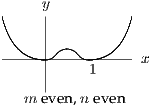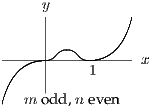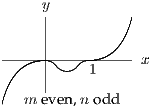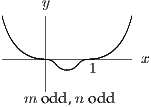Problem 24: Sketching ( ) 2002 Paper I
Let , where and are both integers greater than 1. Show that
Show that the curve has a stationary point in the interval . By considering , show that this stationary point is a maximum if is even and a minimum if is odd.
Sketch the graphs of in the four cases that arise according to the values of and .
Comments
There is quite a lot in this question, but it is one of the best STEP questions on basic material that I came across.
First, you have to find . The very first part (giving a form of ) did not occur in the original STEP question. This particular expression is extremely helpful when if comes to finding the value of at the stationary point. In the actual exam, a handful of candidates successfully found a general expression for in terms of then evaluated it at the stationary point: first class work.
You should find that the value of at the stationary point can be expressed in the form , where the factor in the brackets is quite simple and always negative, so that the nature of the stationary point depends only on the sign of . Actually, this is intuitively obvious: so the one stationary point with must be, for example, a maximum if for .
For the sketches, you really have only to think about the behaviour of when is large and the sign of between and . That allows you to piece together the graph, knowing that there is only one stationary point between and . You should then be able to identify the four cases referred to.
Note that, very close to , so it is easy to see how the graph there depends on and ; you can use this to check that you have got the graphs right.
Post-mortem
Don’t read this until you have worked through the question!
You may have noticed a little carelessness in the first line of the solution: what happens in the logarithmic differentiation if any of or or are negative? The answer is that it doesn’t matter. One way to deal with the problem of logs with negative arguments is to put modulus signs everywhere using the correct result
If you are not sure of this, try it on taking the two cases and separately.
A more sophisticated way of dealing with logs with negative arguments is to note that . We don’t have to worry about because it is a constant (of some sort) and so won’t affect the differentiation. Actually, a value of can be obtained by taking logs of Euler’s famous formula giving .
Solution to problem 24
The first result can be established by differentiating directly, but the neat way to do it is to start with :
as required. Writing this as , we see that has stationary points at and (since and ) and when
i.e. when . Solving this last equation for gives , which lies between and since and are positive.
Next we calculate . Starting with
we obtain
At a stationary point, the second of these two terms is zero because , leaving
The bracketed expression is negative so at a stationary point if and if .
The sign of for is the same as the sign of , since when . For the stationary point in the interval , if is even and if is odd. Thus if is even and if is odd, which is the required result.
The four cases to sketch are determined by whether and are even or odd. The easiest way to understand what is going on is to consider the graphs of and separately, then try to join them up at the stationary point between and . If is odd, then is a point of inflection, but if is even it is a maximum or minimum according to the sign of . You should also think about the behaviour for large . All the various bits of information (including the nature of the turning point investigated above) should all piece neatly together.











